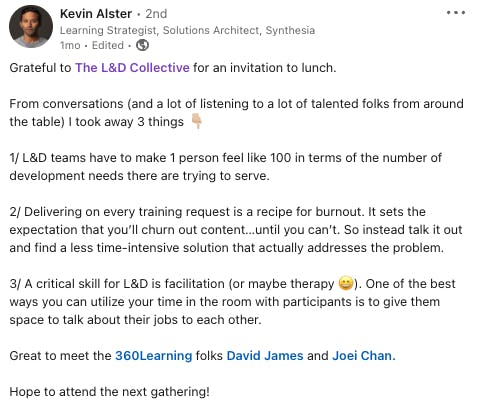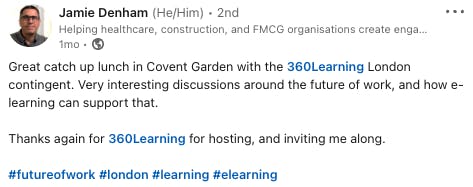The L&D Collective is the go-to global community where L&D leaders come together to share knowledge, build relationships, and experience collaborative learning in action. From time to time, we enjoy meeting up in person, and our recent lunch, organized for our London members was no exception!
We chatted about how great the food was, the fact that people always look different in real life than they do on a Zoom call, and most importantly, we talked about all the wonderful things each of us is doing in Learning and Development (and of course the challenges that come with it). Here’s a recap of our main takeaways.

1. The growing importance of product management in L&D
Viewing an L&D approach with a product management lens is growing in prominence due to its focus on delivering demonstrable and meaningful value. We talked about why it’s important to understand the goals of the business and what teams are doing to deliver on those objectives. We noted that leveraging product management methodologies and ways of working can help refine and prioritize projects, for example by using a backlog.
We also shared that by working with the agile methodology, L&D teams can ship projects faster, iterating on their progress so that they can achieve impact quicker. This helps teams prove their value, enabling them to do more of what works in the future.
2. Stakeholders don’t need what they think they need
L&D has traditionally been a service to the rest of the organization. Teams define formal learning programs around topics or initiatives selected by senior leadership teams or heads of departments. We had some really interesting discussions around this topic and many members said that from their experience, sometimes, stakeholders don’t always need what they think they need.
We all agreed that when you dig a bit more and start asking questions, often you come to the conclusion that what stakeholders need is something entirely different. Sometimes, it might not even be any training! For this reason, it’s important L&D leaders take a consultative approach to understand what’s really needed.

3. L&D should facilitate learning, not teach
We discussed that the best training stems from asking learners questions about what challenges they repeatedly come up against. Sometimes, just starting that conversation in an open environment can help people learn from one another. We agreed that this collaborative approach to content creation is the most effective way to support and guide learners when they need it.
4. Why buying an LMS filled with generic content always fails
We talked about how often L&D teams make the same mistake under the guise of progress for any given organization. We noted that we often buy a learning management system (LMS) and fill it with generic content because it seems like a logical step but this almost always fails because the content lacks cultural context. As a first step, we need to consider how things are done at that organization and what the problems are, then create content that is going to support employee performance.
5. The distant relationship between L&D and Finance
We spoke about the fact that many L&D leaders often don’t have an established relationship with the finance department. We agreed that the relationship doesn’t exist because we’ve rarely had to attribute dollars—the savings or impact—to our work. But by developing this relationship with Finance, L&D leaders have a great opportunity to better align with business goals and prove their value. After all, speaking in “money” is the best way to bring business units together.
We concluded that while metrics such as employee engagement and satisfaction are useful, they are just indicators. Ultimately, they won’t tell us if we’ve achieved cost savings or if we’ve made a real difference to the business. For this reason, it’s really important that L&D teams leverage the data around them to understand the problem, implement a solution, then review the data from the outset to determine whether impact has been achieved.

6. Why content decentralization can be scary for L&D leaders
Many L&D leaders wish more subject-matter experts (SMEs) would help create content—there are simply not enough hours in the day for us to do it all. But what happens when you do get SMEs involved and you start decentralizing content creation? All of a sudden, you’ve got issues with quality—the look and feel of the training materials going out is different and there’s no sense of cohesion.
For this reason, decentralizing content creation can be daunting for some L&D leaders. The top tips that emerged from our conversations were around finding the right balance between pushing content that is on brand but equally not spending so much time on it that it becomes outdated.
It’s imperative to make brand guidelines accessible to all authors and to provide a checklist on what training should look like before they get started. This will help avoid any nasty surprises at the end, whether that’s the L&D team needing to make changes to the course or the author having to re-do some of their work.
7. Recognising the importance of emotions in development
Recognising that emotions play an enormous role in our development is crucial. For example, when learning to become a manager, it can feel uncomfortable, it can be anxiety inducing, and people can be fearful of confronting difficult situations. We recognised that our learning programs can’t only account for the logical, intelligent transfer of knowledge and know-how, otherwise we’re not equipping people properly. When designing learning experiences we need to ask ‘how can we stimulate the emotional experience?’
Join the conversation
Our L&D Collective members spent a great afternoon sharing best practices, challenges, and advice. But don’t just take our word for it! Here’s some feedback we had from some of the L&D Collective members who joined us.



Eager to be part of the conversation? Sign up to join the L&D Collective and receive your own invitation.


